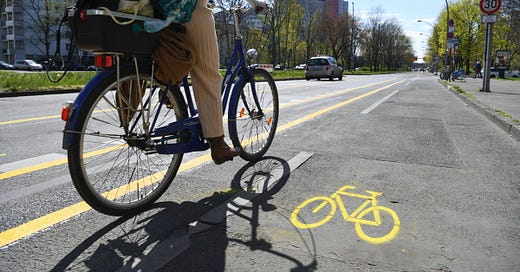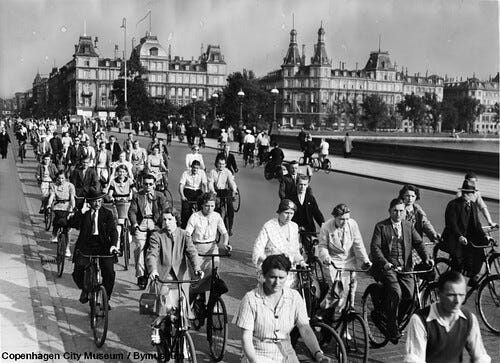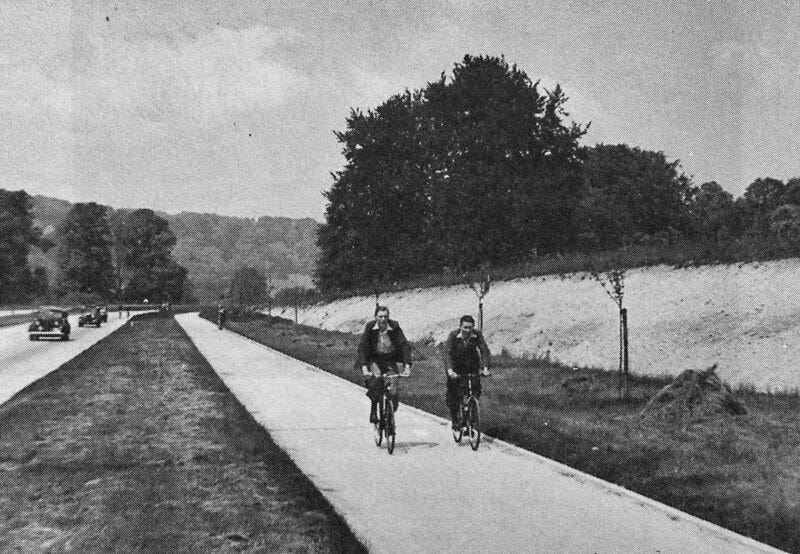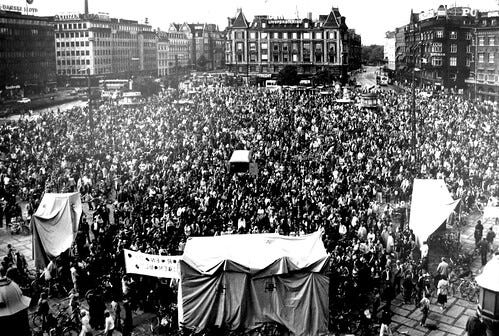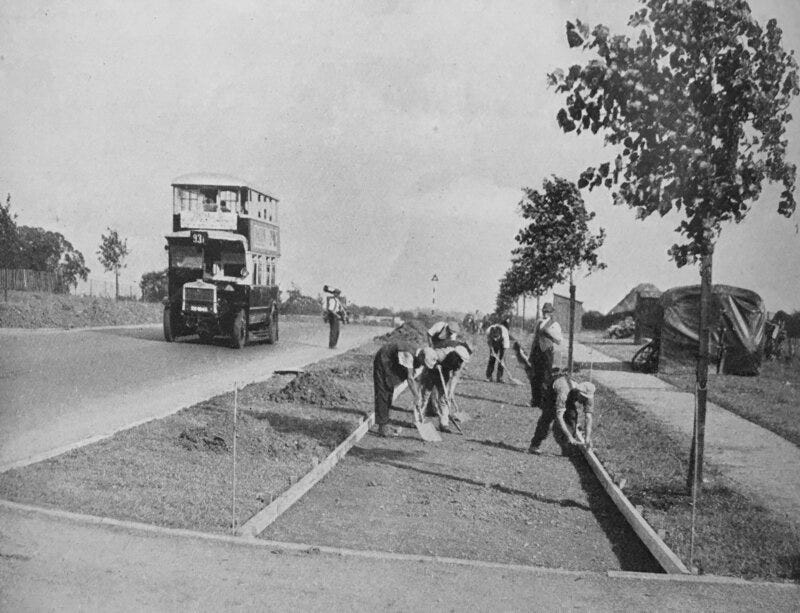For January, I’m releasing a multi-part series on the history of the bicycle. This is not a chronological history; rather, it’s a thematic one. Each entry explores one idea central to the development of the bicycle.
Past installations have covered tricycles and bloomers.
Bike lanes are hot right now: Dallas, TX, just invested $2 million in updating its biking infrastructure. Cambridge, MA, plans to install 23 miles of bike lanes by 2026. And New York City mayor Eric Adams promised to add 300 miles of protected bike lanes to the city.
Politicians and planners throughout the 20th century have used the bike lane to present different visions of the future. Today, the lanes are about promoting cycling –– stemming from contemporary interests in wellness and sustainability –– but a hundred years ago, bike lanes were intended to do the opposite: Discourage cycling.
In the early 1900s, the bicycle became ubiquitous. No longer a technology limited to the urban upper-middle class, workers around the world started using bikes to transport goods, commute, and do their daily business. But, just as the bike’s everyday ubiquity was on the rise, the car (hailed as the future of transportation!) arrived on the streets of Europe.
Thus, a conflict between car and cycle was born. And the bicycle lane sat at the heart of this tension.
The battle over the bike lane began in the late 1920s. Before the 1920s, when cars were still nascent in Europe, cycling organizations were the dominant voice in urban design. They opposed the construction of bike lanes, instead advocating for improved road conditions for all; because cars were a rarity, cyclists could envision a safe, shared space.
But, in the 1920s, new professions –– like civil and traffic engineers –– became the leading experts on urban design, challenging the influence of the bicycle societies. These engineers expected that motorized transportation would inevitably (and rightfully) substitute for old-fashioned bicycles, so they saw the bicycle as an obstacle to modern mobility.
Thus, as a part of larger urban design initiatives, nations built separate lanes for bikes. These lanes were intended to literally push bikes aside. As Swedish engineer Einar Nordendahl put it in 1936: “The construction of special lanes for bicyclists and pedestrians is to a large degree motivated by the urge to free the main lane from such traffic elements.”
For instance, in Germany, urban planners systematized bicycle lane design; they did so not to create comfort for riders but to take cyclists off the road through segregation. The Nazi regime later implemented laws that coerced cyclists to use bike lanes, citing a need to increase traffic flow and prevent road chaos.
In this interwar “car v. cycle” discourse, urban leaders always blamed the cycle for traffic congestion and accidents. In turn, policymakers sought to discourage cycling. For example, in 1937, the mayor of Antwerp, Belgium, proposed prohibiting cyclists from riding side-by-side, and the city closed off many roads to cyclists.
This mentality persisted after World War II, with engineers continuing to see the bicycle as anachronistic and the car as the future. Thus, the war-torn cities of Europe provided an opportunity for urban planners to rebuild environments specifically for the automobile.
This postwar reconstruction led to a dismantling of biking infrastructure. Policymakers suspended new bike lane construction and destroyed existing lanes to create space for cars. For instance, in Hannover, Germany, cyclists were prohibited from riding on many inner city streets, and in Basle, Switzerland, cars were allowed to park in bike lanes and on sidewalks. In short, bicycle infrastructure was erased from policy agendas, and cyclists felt like they were being treated as the “pariahs of the road,” in the words of the Antwerp cycling organization.
However, the bike lane is back. This switch began in the 1960s with activists who, fed up with car congestion and car pollution, promoted cycling as a way to slow down urban speed and improve city life, health, and the environment. Many of these activitists were able to successfully add the bicycle back into integrated traffic plans after more than two decades of erasure. In the 1970s and 1980s, environmental awareness, the energy crisis, and the economic recession forced policymakers to develop more bike-friendly attitudes. The bicycle lane was, once again, a useful policy instrument, but its meaning changed from a tool to segregate off cyclists to a tool to promote cycling.
We’re still living in this pro-lane world. Because biking is a COVID-safe activity, the pandemic has fueled the construction of new bike lanes, and cities around the world are continuing to invest in the infrastructure.
However, the bike lane is a contested space, shaped by an ongoing conflict between the car and the cycle. The lane is a political tool. In turn, its construction and destruction reflects our changing ideas of what an “ideal urban future” might look like. No matter the imagined future –– of motorized mobility or of environmental sustainability –– we’ll be riding our bikes to get there.
Notes:
This post is adapted from Ruth Oldenziel and Adri Albert de la Bruheze’s article “Contested Spaces: Bicycle Lanes in Urban Europe, 1900-1995” (Transfers, 2011). There’s a lot more detail and depth on bike lanes in the paper, for those interested.
This post focuses solely on bike lanes in Europe. I’d caution against extrapolating the claims to other continents, though I think there are some similarities to American bike lane history (especially after World War II).

